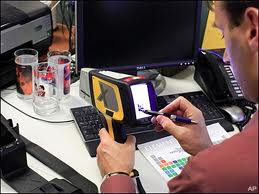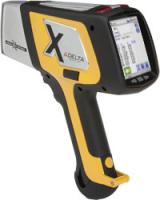Import Safety and Border Security
Focus The sheer volume of materials passing through Border Security makes extensive materials testing at a lab impractical. The same is true for Non-Proliferation metal inspections that help prevent the spread of Weapons of Mass Destruction (WMD). With an Olympus portable XRF analyzer, inspectors can test materials right on a vehicle, at the loading dock, or at remote sites the world over. As a result, significantly more materials can be tested quickly and non-destructively. High volume, on-the-spot testing, and thus enforcement, becomes a reality. |  |
Non-Proliferation: Securing World Safety
Finding and tracking shipments of materials intended for clandestine WMD programs is critical. Often shipments of materials are deliberately mislabeled as a common steel. The DELTA Handheld XRF can test for this in seconds. Inspectors typically look for Zr, W, Nb, Hf, Ni, Ti, Ta, and Cr, elements characteristic of highly specialized alloys used in the manufacture of nuclear reactors. Specialized aluminum alloys, with a specific chemistry used for U enrichment, can tip-off the inspectors to its true intended use.
 | Border Security: Protecting Our Safety and Way of LifeThere are more than 15,000 primary border inspectors in the US alone. Border controls work to keep out obviously banned items, such as illegal drugs and weapons. They also work to protect us from seemingly innocent items that could be intended for WMD's or contain toxic levels of metals. Olympus Innov-X portable XRF analyzers enable immediate detection of products containing these metals, before they cross the border. For example in the early 1990s, paprika consumed in Hungary was found to contain percentage levels of Pb, but only after resulting in several deaths and significant levels of illness. The actual cause - whether accidental or intentional - was never determined. |
Some countries have no restrictions on toxic metal content when manufacturing items used by children. Imported crayons, sidewalk chalk, plastic toys and furnishings could contain toxic levels of metals in additives. The greatest problem is with additives that are not chemically bound and can leach out. These are typically found in stabilizers (Cd, Pb), flame retardants (Sb, Br) and colorants (Cd, Pb, Cr). Chewing on an item like a plastic toy or crayon could release toxic metals that would otherwise lie dormant. A similar problem exists for imported decorative food wares. Toxic levels of Pb and Cd could leach out of imported silverplated hollowware.
Enforcing FDA quality control regulations is also vital. For example, the USFDA mandates that surgical stainless steels contain at least 12% Cr. However imported surgical instruments are often found to contain significantly less than the minimum Cr content. Portable XRF is an excellent inspection tool for this problem, as large quantities of pieces can be tested quickly at the port of entry with no damage to the materials tested.
The events of 9-11 in the US precipitated the world's economy to shift from what was once a "just in time" delivery driven market to a "smart borders" delivery driven market. Olympus Innov-X portable XRF analyzers provide a vital tool to help border security officers make sure that a "smart borders" delivery system moves imports as accurately, safely and as close to "just in time" as possible.


